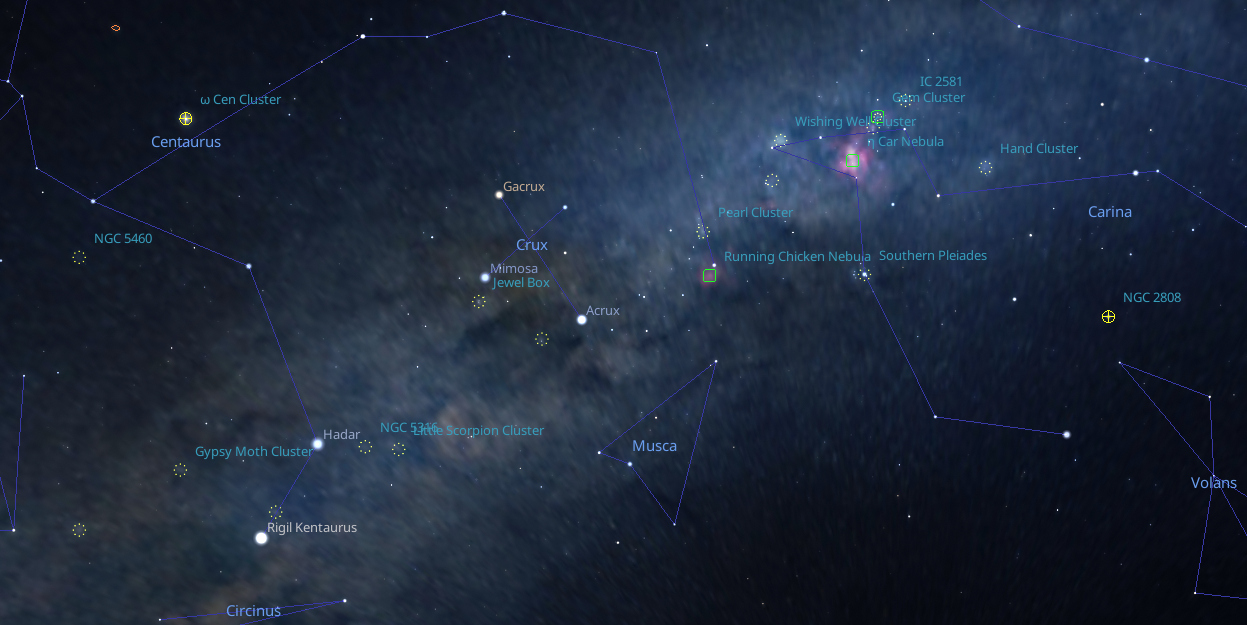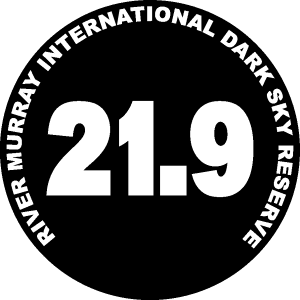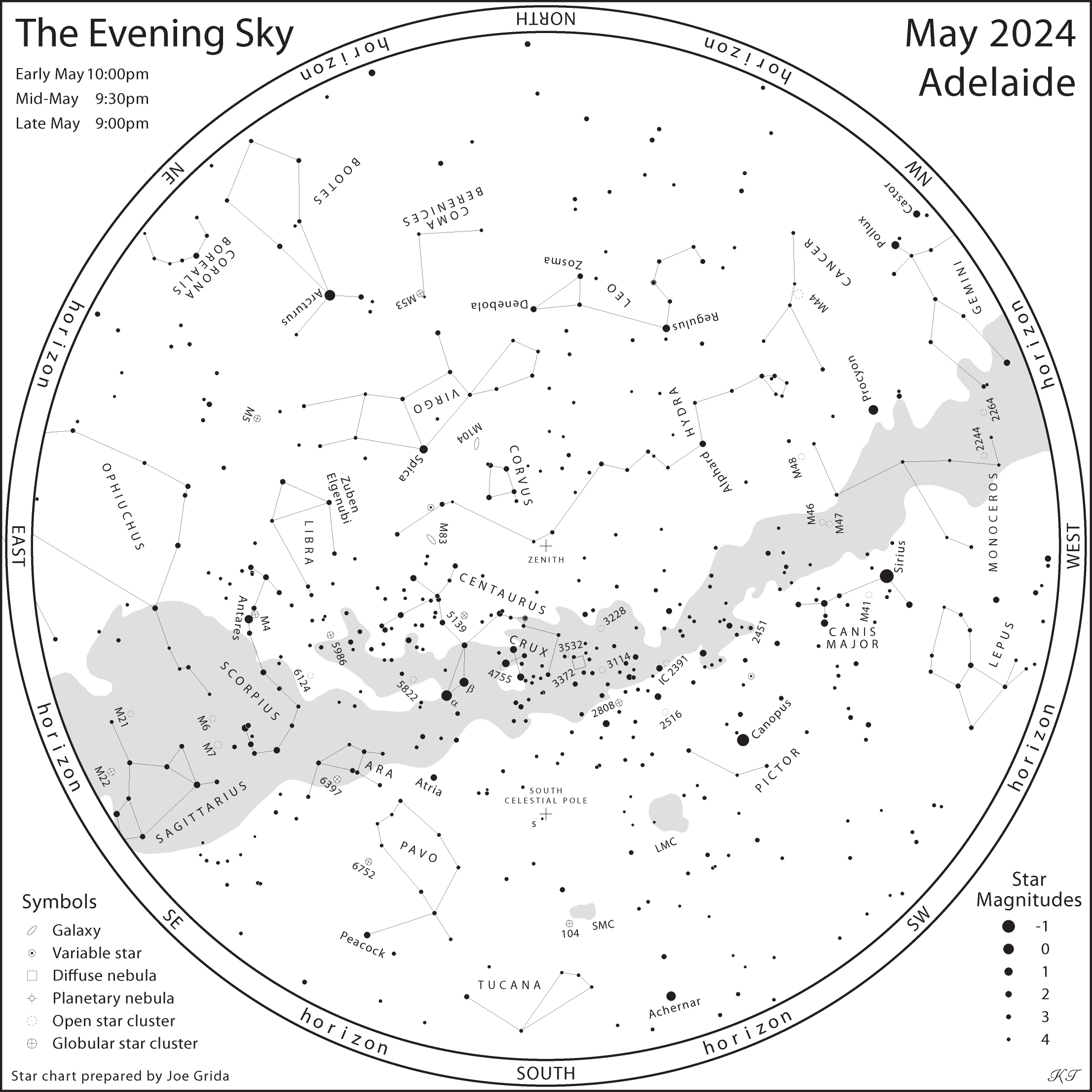A myriad of bright stars adorn the late autumn evening sky.
Blue-white Regulus, the heart of Leo, the lion, stands half-way up the north-western sky. Yellow-orange Arcturus, one of the brightest stars in the night sky, is well up in the north-east. And all around the heavens, you'll see many other stars in shades of blue, white, yellow, orange, and red.
The dominant constellation in our evening sky is Scorpius, the Scorpion; one of the few constellations in our sky that actually resembles what it is supposed to represent. He makes his presence noticed in the eastern sky. He will keep us company over the coming chilly winter months. Its brightest star, Antares, is a huge star of gargantuan proportions. If we replaced our Sun with it, then all the planets from Mercury through to Jupiter would all find themselves engulfed within it! Just below the tail of Scorpius, you can find the star clusters designated M6 and M7. Take the trouble to observe these with binoculars. They make a beautiful sight, with many bright stars sparkling like diamonds against a background of gold dust.
Further to the north, we find the constellation of Virgo. One of the most famous objects in the sky; a quasar known as 3C273, is located in this constellation. In the early 1960’s, 3C273 was known as a "radio star." Though astronomers could detect it with radio telescopes, they couldn't pinpoint its location well enough to see it with optical telescopes.
But that changed the day the Moon passed between the radio star and Earth, blocking its radio signals and allowing astronomers to pinpoint its location. With this information, they could find the object with optical telescopes for the first time.
Even then, they couldn't quite fathom what they saw. Photographic plates showed only an inconspicuous blue star. But when astronomers split the star's light into its individual wavelengths, they found that it was unlike any known star, galaxy, or nebula. Further study eventually revealed that it's over 3.5 billion light-years away, which means it must be incredibly bright. It's also small, which means its energy source must be incredibly powerful.
Today, astronomers believe that 3C 273 and the thousands of other known quasars are monstrous black holes encircled by disks of gas. As gas spirals into the black hole it's heated, so it glows brightly; bright enough to be seen across the vast abyss of space and time.

Above: The area around the Southern Cross abounds with many celestial wonders. You are encouraged to grab a pair of binoculars and scan this area. Chart generated with Stellarium v23.3 planetarium software.
During early May, the Earth crosses the orbit of Comet Halley, and this produces one of the southern hemisphere’s most famous meteor showers, the Eta Aquarids, named for the star in the constellation of Aquarius, from near which the meteor shower appears to originate. If you’re brave enough to venture outside at about 3.00am, look about 10 degrees up the eastern sky. Spend some time looking and you could be rewarded with up to 60 or more “shooting stars” per hour. The best time is around May 5-6.
Comets are small, fragile, irregularly shaped bodies composed of a mixture of dust and frozen gases. Think of a comet as a “dirty snowball”. They usually follow highly elongated paths around the Sun. Most become visible, even in telescopes, only when they get near enough to the Sun for the Sun's radiation to start evaporating the volatile gases, which in turn blow away small bits of the solid material, usually no bigger than dust grains. These are left behind by the comet and form what astronomers call meteor streams.
If the Earth's orbit crosses through a meteor stream, these small particles enter the Earth’s atmosphere at great speed, typically at over 40,000 kms per hour. The friction generated by this re-entry completely vaporises the dust, resulting in a brief bright flash, usually referred to as a shooting star. When we strike a large number of these particles, we experience a meteor shower.
Shift your gaze to the south, and find the Southern Cross high in the sky. Surrounding it on three sides is the constellation of Centaurus, the centaur. Its two brightest stars, Alpha and Beta Centauri, are referred to as the Pointers, because they follow the Southern Cross around the sky and always point to it. Alpha Centauri is actually the closest star system to the Earth other than our own Sun, at a distance of just over 4 light years.
The third brightest star in the Southern Cross is Gamma Crucis; you can locate it at the apex of the cross. In the early evening during May, it is the highest in the sky of the stars that make up the Southern Cross. Look at it carefully, and you’ll see that it is a red star. It is a prelude of what will happen to our Sun.
Today, our Sun is a yellow star, steadily fusing hydrogen into helium at its core. Billions of years from now, though, it’ll use up its hydrogen. The Sun will expand, engulfing the planet Mercury, and possibly Venus and even Earth, and its surface layers will cool and redden. In other words, the Sun will become a red-giant star.
But that won’t happen for another five billion years or so. For now, Gamma Crucis is the closest red giant to Earth, at a distance of almost 90 light-years. This bright star produces about as much energy in an hour as the Sun does in an entire week.
As a red giant, Gamma Crucis is nearing the end of its life. Someday, it’ll cast its outer layers into space, exposing its hot, dense core. Eventually, over billions of years, the leftover core will cool, leaving only an invisible cosmic cinder.
Between the Southern Cross and the southern horizon, you’ll notice two small fuzzy blobs in the sky – these are the Large and Small Magellanic Clouds. You’ll need a dark sky to see these. When the first Portuguese explorers sailed into southern waters, they saw these faintly glowing clouds that weren't visible from their homeland. They named the little clouds for Ferdinand Magellan, the explorer who'd organized the first trip around the world. The Magellanic Clouds became beacons for southern navigators.
The Large Magellanic Cloud is the closer of the two, at a distance of about 170,000 light-years, whilst the Small Magellanic Cloud is about 40,000 light-years further than the large cloud. Due to their nearness, both galaxies serve as excellent laboratories for studying the universe. They contain a variety of stars, giant clusters of fairly young stars, and big clouds of gas in which new stars are being born.
Measuring the distances to other galaxies is a tough problem. In fact, it would be all but impossible without a discovery that was reported just over 100 years ago. The discovery was made by Henrietta Leavitt, an assistant at Harvard College Observatory.
She was studying stars in the Magellanic Clouds. She found hundreds of stars that regularly brightened and faded. Leavitt discovered that there was a relationship between how bright the stars got and how long it took them to brighten.
The discovery was one of the most important of 20th-century astronomy. That’s because it provided a way to measure the relative distances to these stars, and therefore to their parent galaxies. Just measure the length of a star’s pulse, then see how bright the star looks. Stars that look fainter must be farther away.
Later, astronomers turned the relative distance into absolute distance when they realized that there are similar stars in our own galaxy; close enough to measure their distances with other techniques. With the distances to a few of the stars, astronomers could then calculate the distances to any of them just by measuring the star’s brightness and the length of its pulses.
These types of stars are bright enough to see in galaxies that are up to 50 million light-years away. So these “flickering” stars provide a way to measure distances to the closest galaxies - a first step in measuring the distances to all galaxies.
The Moon is at Last Quarter on the 1st of May, New on the 8th, at First Quarter on the 15th, Full on the 23rd, and at Last Quarter again on the 31st of May
Happy stargazing!


